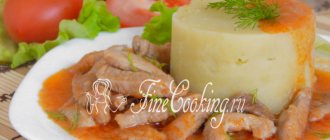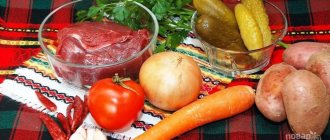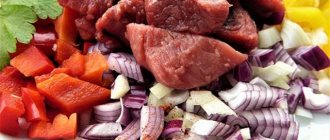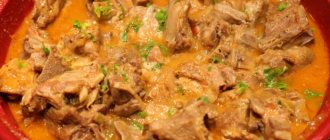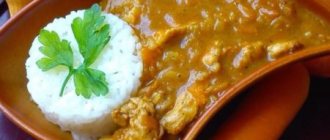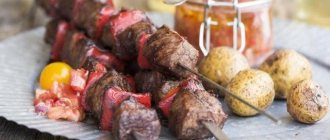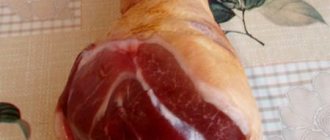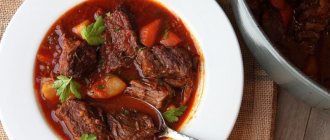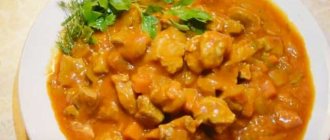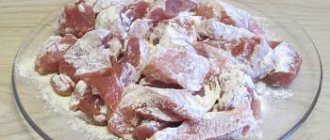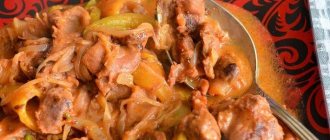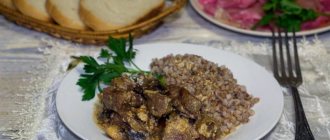Beef sauce is a very common dressing; its main components are both dairy products (sour cream, cream, cheese, butter) and wine and balsamic bases.
Boiled, stewed, baked beef are mainly dietary dishes and therefore require an interesting accompaniment in order to complement and reveal the taste of the meat.
Mustard cream sauce for beef
This is an original dressing for serving with baked beef, the main ingredients of which are only 3 components.
Ingredients:
- small finely chopped shallot – 1 pc.;
- heavy cream – 250 ml;
- Dijon mustard – 2 tbsp;
- frying oil (vegetable) – 2 tbsp;
- salt, pepper - a pinch.
Creation stages:
- Fry the pre-cooked shallots in a frying pan with heated vegetable oil until soft and transparent, about 5 minutes;
- Pour in a glass of heavy cream and simmer over low heat for another 2-3 minutes.
- Remove from heat and whisk Dijon mustard into the resulting mixture, season with pepper and salt.
Onion sauce for beef
- blue onion – 0.5 kg;
- sugar – 40 g;
- dry red wine – 50 ml;
- wine vinegar (6 percent) – 40 ml;
- olive oil – 30 ml;
- salt - to taste.
Cooking method:
- Peel the onion and cut into small pieces.
- Fry until translucent in olive oil.
- Add the remaining ingredients, stir and simmer over low heat for an hour. Stir the sauce occasionally to prevent the onions from burning.
The consistency of the onion sauce resembles liquid marmalade. If desired, it can be prepared in large quantities, distributed into molds and frozen. In this case, it can be used for 2 months.
Balsamic sauce for beef
Red wine dip can be used not only as a sauce for beef, but also as a marinade for raw meat.
For refueling you need to prepare in advance:
- dry red wine – 250 ml;
- balsamic vinegar – 250 ml;
- finely chopped rosemary leaves - 1 tbsp.
Process:
- Pour wine and balsamic vinegar into a small saucepan.
- Add fresh, finely chopped rosemary leaves and let it boil.
- Simmer over low heat until the mass thickens and reduces by half in volume (this is about 15-20 minutes), season with salt and pepper.
Beef in plum sauce
In addition to being served with meat dishes, plum sauce can also be used for marinating and cooking different types of meat. In the following recipes you will learn how to do this. So, we present the recipe for beef in plum sauce. With this cooking method, meat acquires a slightly sour taste, a spicy-garlic aroma, softness and juiciness.
- Beef - 0.5 kg (better lean part)
Cooking beef in plum sauce:
- Wash the beef, cut off the film and all the fat, and cut into thin strips, 5 cm long and 1 cm thick, which are placed in any shape. If you first put the meat in the freezer for 25 minutes, it will be easier and thinner to cut.
Garlic mushroom sauce
Mushroom dip is good for its versatility. It can be used not only for baked beef, but also for side dishes: spaghetti, potatoes (fried or boiled).
Components:
- sweet butter – 55 g;
- straw-covered champignons – 450 g;
- pressed garlic – 2 cloves;
- salt, pepper - to taste.
Prepare the beef sauce:
- Melt half of the prepared butter in a deep saucepan over medium heat.
- Add the champignons and fry until they are soft and golden brown (6-7 minutes).
- Add the pureed garlic and cook until fragrant, about a minute.
- Add the second part of the butter and stir until it melts, add salt and pepper. Serve with baked beef.
Recipe Potato sauce with beef. Calorie, chemical composition and nutritional value.
Nutritional value and chemical composition of Potato Sauce with Beef.
The table shows the nutritional content (calories, proteins, fats, carbohydrates, vitamins and minerals) per 100 grams of edible portion.
| Nutrient | Quantity | Norm** | % of the norm in 100 g | % of the norm in 100 kcal | 100% normal |
| Calorie content | 110.2 kcal | 1684 kcal | 6.5% | 5.9% | 1528 g |
| Squirrels | 7.9 g | 76 g | 10.4% | 9.4% | 962 g |
| Fats | 4.8 g | 56 g | 8.6% | 7.8% | 1167 g |
| Carbohydrates | 8.7 g | 219 g | 4% | 3.6% | 2517 g |
| Organic acids | 0.3 g | ~ | |||
| Alimentary fiber | 0.9 g | 20 g | 4.5% | 4.1% | 2222 g |
| Water | 26.2 g | 2273 g | 1.2% | 1.1% | 8676 g |
| Ash | 0.681 g | ~ | |||
| Vitamins | |||||
| Vitamin A, RE | 90.1 mcg | 900 mcg | 10% | 9.1% | 999 g |
| beta carotene | 0.541 mg | 5 mg | 10.8% | 9.8% | 924 g |
| Vitamin B1, thiamine | 0.067 mg | 1.5 mg | 4.5% | 4.1% | 2239 g |
| Vitamin B2, riboflavin | 0.083 mg | 1.8 mg | 4.6% | 4.2% | 2169 g |
| Vitamin B4, choline | 24.08 mg | 500 mg | 4.8% | 4.4% | 2076 g |
| Vitamin B5, pantothenic | 0.391 mg | 5 mg | 7.8% | 7.1% | 1279 g |
| Vitamin B6, pyridoxine | 0.334 mg | 2 mg | 16.7% | 15.2% | 599 g |
| Vitamin B9, folates | 9.369 mcg | 400 mcg | 2.3% | 2.1% | 4269 g |
| Vitamin B12, cobalamin | 0.891 mcg | 3 mcg | 29.7% | 27% | 337 g |
| Vitamin C, ascorbic acid | 5.36 mg | 90 mg | 6% | 5.4% | 1679 g |
| Vitamin E, alpha tocopherol, TE | 1.624 mg | 15 mg | 10.8% | 9.8% | 924 g |
| Vitamin H, biotin | 1.562 mcg | 50 mcg | 3.1% | 2.8% | 3201 g |
| Vitamin K, phylloquinone | 0.4 mcg | 120 mcg | 0.3% | 0.3% | 30000 g |
| Vitamin RR, NE | 3.8187 mg | 20 mg | 19.1% | 17.3% | 524 g |
| Niacin | 1.614 mg | ~ | |||
| Macronutrients | |||||
| Potassium, K | 376.68 mg | 2500 mg | 15.1% | 13.7% | 664 g |
| Calcium, Ca | 11.54 mg | 1000 mg | 1.2% | 1.1% | 8666 g |
| Magnesium, Mg | 20.97 mg | 400 mg | 5.2% | 4.7% | 1907 |
| Sodium, Na | 14.39 mg | 1300 mg | 1.1% | 1% | 9034 g |
| Sera, S | 100.8 mg | 1000 mg | 10.1% | 9.2% | 992 g |
| Phosphorus, Ph | 78.3 mg | 800 mg | 9.8% | 8.9% | 1022 g |
| Chlorine, Cl | 67.43 mg | 2300 mg | 2.9% | 2.6% | 3411 g |
| Microelements | |||||
| Aluminium, Al | 391.2 mcg | ~ | |||
| Bor, B | 59.8 mcg | ~ | |||
| Vanadium, V | 61.73 mcg | ~ | |||
| Iron, Fe | 1.376 mg | 18 mg | 7.6% | 6.9% | 1308 g |
| Yod, I | 5.59 mcg | 150 mcg | 3.7% | 3.4% | 2683 g |
| Cobalt, Co | 7.129 mcg | 10 mcg | 71.3% | 64.7% | 140 g |
| Lithium, Li | 32.097 mcg | ~ | |||
| Manganese, Mn | 0.1179 mg | 2 mg | 5.9% | 5.4% | 1696 g |
| Copper, Cu | 169.04 mcg | 1000 mcg | 16.9% | 15.3% | 592 g |
| Molybdenum, Mo | 10.077 mcg | 70 mcg | 14.4% | 13.1% | 695 g |
| Nickel, Ni | 5.202 mcg | ~ | |||
| Tin, Sn | 25.95 mcg | ~ | |||
| Rubidium, Rb | 236 mcg | ~ | |||
| Selenium, Se | 0.178 mcg | 55 mcg | 0.3% | 0.3% | 30899 g |
| Fluorine, F | 35.91 mcg | 4000 mcg | 0.9% | 0.8% | 11139 g |
| Chromium, Cr | 7.08 mcg | 50 mcg | 14.2% | 12.9% | 706 g |
| Zinc, Zn | 1.4174 mg | 12 mg | 11.8% | 10.7% | 847 g |
| Digestible carbohydrates | |||||
| Starch and dextrins | 6.095 g | ~ | |||
| Mono- and disaccharides (sugars) | 2.9 g | max 100 g | |||
| Glucose (dextrose) | 0.4096 g | ~ | |||
| Sucrose | 0.7582 g | ~ | |||
| Fructose | 0.1471 g | ~ | |||
| Essential amino acids | 0.3259 g | ~ | |||
| Arginine* | 0.0525 g | ~ | |||
| Valin | 0.0535 g | ~ | |||
| Histidine* | 0.0137 g | ~ | |||
| Isoleucine | 0.0392 g | ~ | |||
| Leucine | 0.0575 g | ~ | |||
| Lysine | 0.0608 g | ~ | |||
| Methionine | 0.0117 g | ~ | |||
| Methionine + Cysteine | 0.0226 g | ~ | |||
| Threonine | 0.0437 g | ~ | |||
| Tryptophan | 0.0131 g | ~ | |||
| Phenylalanine | 0.0441 g | ~ | |||
| Phenylalanine+Tyrosine | 0.0846 g | ~ | |||
| Nonessential amino acids | 0.5453 g | ~ | |||
| Alanin | 0.0453 g | ~ | |||
| Aspartic acid | 0.1123 g | ~ | |||
| Glycine | 0.0449 g | ~ | |||
| Glutamic acid | 0.1296 g | ~ | |||
| Proline | 0.0409 g | ~ | |||
| Serin | 0.0558 g | ~ | |||
| Tyrosine | 0.0397 g | ~ | |||
| Cysteine | 0.0107 g | ~ | |||
| Sterols (sterols) | |||||
| beta sitosterol | 5.7143 mg | ~ | |||
| Saturated fatty acids | |||||
| Saturated fatty acids | 0.4 g | max 18.7 g | |||
| 14:0 Miristinovaya | 0.0008 g | ~ | |||
| 16:0 Palmitinaya | 0.2066 g | ~ | |||
| 18:0 Stearic | 0.1234 g | ~ | |||
| 20:0 Arakhinovaya | 0.0086 g | ~ | |||
| 22:0 Begenovaya | 0.02 g | ~ | |||
| Monounsaturated fatty acids | 0.7488 g | min 16.8 g | 4.5% | 4.1% | |
| 16:1 Palmitoleic | 0.0021 g | ~ | |||
| 18:1 Oleic (omega-9) | 0.7434 g | ~ | |||
| Polyunsaturated fatty acids | 1.7425 g | from 11.2 to 20.6 g | 15.6% | 14.2% | |
| 18:2 Linolevaya | 1.7417 g | ~ | |||
| 18:3 Linolenic | 0.034 g | ~ |
The energy value of Potato sauce with beef is 110.2 kcal.
Primary Source: Created in the application by the user. Read more.
** This table shows the average levels of vitamins and minerals for an adult. If you want to know the norms taking into account your gender, age and other factors, then use the “My Healthy Diet” application.
Tarragon béarnaise
Beef stew is not only tasty, but also healthy. Thanks to the low temperature and long cooking time, the meat is tender, soft and flavorful.
Stewed beef can be served with both simple sauces, for example, sour cream, cream, and complex ones, consisting of combinations of herbs and various ingredients.
Béarnaise is a complex sour cream marinade, similar to mayonnaise, but with an unsurpassed aroma. If done correctly, the dressing will give the meat the necessary piquancy and bring out its flavor to the fullest.
For preparation you will need:
- butter – 25 gr.;
- fat sour cream – 100 gr.;
- Dijon mustard – 5 gr.;
- white wine vinegar – 4 g;
- shallots – 1 pc.;
- capers – 0.5 teaspoon;
- finely chopped tarragon - 2 tbsp.
Culinary process:
- Cook the meat without seasonings and spices, only with the addition of water for stewing in a cauldron, for one and a half hours.
- In a separate non-stick frying pan, dissolve a measured amount of oil, add pre-chopped shallots.
- Saute for 5 minutes, pour in white wine vinegar and simmer for another two minutes.
- Add sour cream, mustard, capers and tarragon. Reduce heat and simmer for 2-3 minutes until boiling, then remove from heat.
- Turn off the heat under the simmering meat, pour the resulting sauce into the cauldron, stir and let the dish brew under a closed lid for 40 minutes.
The most successful side dish for beef stew with this dressing is mashed potatoes or ratatouille.
With mayonnaise
The option for a hearty and tasty dish described below will certainly not go unnoticed by every owner of a multicooker. The recipe for stewed beef with gravy in this kitchen appliance can be easily reproduced even by those who rarely cook. To do this you will need:
- 130 ml drinking water.
- 600 g young beef.
- 1 carrot.
- 1 onion.
- 3 tbsp. l. tomato dressing.
- 2.5 tbsp. l. mayonnaise.
- Salt, spices and olive oil.
The meat cut into pieces is fried in a multicooker bowl, and then supplemented with vegetables chopped into half rings. All this is simmered for a short time in the switched on device and poured with a sauce made from mayonnaise, spices, water, salt and tomato dressing. Prepare beef stew with gravy in a multicooker operating in the appropriate mode within two hours.
Children's bechamel for boiled beef
Boiled beef is a dietary dish, included in the diet of not only adults, but also children, therefore the gravy for such a dish should be as natural and nutritious as possible.
Ingredients:
- flour - teaspoon;
- lactose-free milk – 100 ml;
- butter - teaspoon;
- sugar syrup – 3 ml.
Preparation:
- Dry the flour in a frying pan preheated without oil for several minutes.
- Cool, sift, place in a small ladle with a thick bottom, dilute with milk and let sit for half an hour.
- Place the ladle on the fire, stir, bring to a boil and boil for 10-15 minutes, stirring and adding milk (if the mixture thickens too much).
- Before serving, stir butter into the sauce.
Classic beef recipe with gravy
If you want to prepare a hearty lunch, then beef stew with gravy is perfect as a main course.
Ingredients:
- 1 kg marinated beef;
- 2 medium onions;
- 1 tbsp. water;
- olive oil (sunflower can also be used);
- 1-2 cloves of fresh garlic;
- salt;
- ground black pepper, khmeli-suneli;
- dry dill and parsley (optional).
Preparation:
- If the meat was previously marinated, then drain the marinade. If not, then peel the beef from the films and cut it into pieces 4 x 4 cm along the grain.
- Cut the onion into rings and place it in a deep pan in hot oil. Close the lid and fry over low heat.
- Add the meat to the fried onions and increase the heat. The moisture should evaporate from the meat. We wait until a golden brown crust forms on the beef - then when stewing, all the juice will remain inside the pieces.
- Pour boiled water over the meat and simmer for about 40 minutes over medium heat.
- Add spices, simmer for about 15 minutes and turn off.
- Serve with rice, pasta or vegetables.
Cheese sauce for beef
An equally tasty dressing for boiled beef is made from simple, affordable and natural ingredients:
- meat broth (cold) – 500 ml;
- butter – 60g;
- yolk of one egg;
- grated hard cheese – 50 g;
- salt, pepper - to taste.
Creative stages:
- Melt 40 g of butter, fry the flour in it until golden brown.
- Pour in the broth, add pepper, cook, stirring, for 10 minutes.
- Add grated cheese, remaining butter and egg yolk, mix and add salt.
- Cut the boiled meat into portions across the grain and pour over the prepared sauce.
Note: if the dish is intended only for adults, you can use 30 g of regular hard cheese and 30 g of blue cheese. This combination of cheeses will add piquancy and a unique aroma to the beef.
PP dinner: beef stew in tomato sauce
Used - 9.97/3.07/3.29
Ingredients: lean beef - 800 grams bell pepper (preferably different colors) carrots - 1 small piece onion - 2 pieces garlic - 3 cloves 1 hot pepper 400 g tomatoes in their own juice Bay leaf 1/4 tsp. ground cinnamon Salt to taste
Preparation: Cut the meat into two pieces across the grain, put it in a saucepan, add chopped carrots, onions, 1 tsp. salt and bay leaf. Pour in a liter of water and bring to a boil, reduce the heat and cook, covered for a couple of hours, until the meat is soft. Then turn off the heat and leave to stand in the broth for half an hour. Remove and cool slightly, tear the meat into fibers with your hands. Cut a large onion into half rings, and pepper into strips. Simmer in a small amount of water for 10 minutes until soft. Add chopped garlic, hot pepper, salt and cinnamon, tomatoes along with juice, mash them with a spoon. Simmer for another 5 minutes. Add 500 ml of broth in which the meat was cooked and beef. Simmer for another 10 minutes.
Bon appetit!
Shall we turn on some music to set the mood?
Now playing:
Open Kluber FM website | iOS app | Android app
